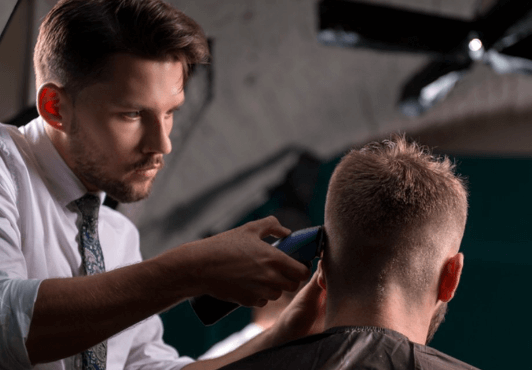Barber vs. Hairstylist: What’s the Difference and Which Career Path is Right for You?

When it comes to choosing a career in the beauty and grooming industry, many aspiring professionals find themselves at a crossroads: should they pursue a career as a barber or a hairstylist? While both professions involve cutting and styling hair, there are key differences that set these two career paths apart. Understanding these distinctions can help you decide which career is best suited for your interests, skills, and long-term goals. If you’re in Mississauga and considering attending barber school Mississauga, this guide will give you a clear picture of what each profession entails and help you make an informed decision.
1. The Roles: Barber vs. Hairstylist
At first glance, both barbers and hairstylists may seem to perform similar tasks. After all, both professionals specialize in cutting and styling hair. However, their roles and the type of services they offer vary significantly.
Barber
A barber typically focuses on providing haircuts and grooming services for men. Barbers are skilled in using clippers, razors, and scissors to create short, classic hairstyles such as fades, tapers, and buzz cuts. Beyond haircuts, barbers are also trained in grooming facial hair, such as beard trimming, shaping, and shaves using straight razors. Some barbershops offer additional services like scalp treatments, but the main focus is often on precision cutting and facial grooming.
See also: How to get perfect Funky Hairstyles for Boys?
Hairstylist
A hairstylist, on the other hand, works with a broader clientele that includes both men and women. Hairstylists are trained to cut, color, style, and treat hair in a variety of ways. They are skilled in a range of hair techniques, including blow-drying, curling, straightening, coloring, and highlighting. While some hairstylists may specialize in men’s hair, the majority provide services for women, including intricate hairstyles for special occasions, chemical treatments like perms, and hair coloring.
2. Training and Education
Both barbers and hairstylists need professional training to develop the necessary skills to excel in their careers. However, the training programs for each profession can differ, especially in terms of focus and duration.
Barber School Mississauga
If you’re looking to become a barber, attending a barber school Mississauga is essential to gaining the technical skills and certifications needed to work in the industry. Barber school programs often focus on men’s haircuts, shaving techniques, and grooming services. In addition to practical skills, these programs usually cover sanitation and hygiene, as well as understanding different hair types and textures. Many barber schools also offer classes on the business side of running a barbershop, including customer service and marketing.
Most barber programs take around 6 to 12 months to complete, depending on whether you attend full-time or part-time. After completing the program, you may need to obtain a license to work professionally as a barber, depending on local regulations.
Hairstylist Training
To become a hairstylist, you’ll typically need to enroll in a cosmetology program that covers a wider range of services compared to a barbering program. These programs provide training in cutting, coloring, and styling hair for both men and women. Hairstylists also learn about chemical treatments like coloring, perming, and relaxing hair. As part of their training, hairstylists are educated on the latest trends in hair fashion, which can be particularly useful for those looking to work in high-end salons or for clients seeking trendy, modern styles.
Cosmetology programs can take longer to complete than barber programs, often ranging from 9 to 18 months. Like barbers, hairstylists must also pass an exam and obtain a license before they can work professionally.
3. Work Environment
The work environment for barbers and hairstylists can be quite different, and your preference for a particular setting might influence your career choice.
Barbershop
Barbers typically work in barbershops, which often have a relaxed, masculine atmosphere. The clientele is predominantly male, and the services offered are tailored to men’s grooming needs. Barbershops often serve as community hubs where men go not only for haircuts but also for social interaction. The classic barbershop experience usually includes services like straight razor shaves, beard grooming, and short, precision cuts.
Barbershops can range from traditional setups with vintage decor to more modern establishments. If you enjoy working in a focused environment where you can specialize in men’s grooming, then working in a barbershop might be the right choice for you.
Salon
Hairstylists typically work in salons, where the atmosphere is more diverse and the services are more varied. Salons cater to both men and women and often have a wider range of clientele. In addition to haircuts, hairstylists in salons may offer hair coloring, blowouts, styling for special events, and chemical treatments. Salons also tend to focus on creating a luxurious, relaxing experience for clients, with services that include hair treatments, scalp massages, and more.
If you enjoy variety in your work and like staying on top of the latest fashion trends, working in a salon might suit you better.
4. Career Opportunities and Specializations
Both barbers and hairstylists have plenty of opportunities to advance in their careers, but the paths to specialization can differ.
Barber Career Opportunities
As a barber, you can specialize in various grooming services, such as advanced beard grooming, hot towel shaves, or scalp treatments. With experience, you could also open your own barbershop or expand your services to include more luxury treatments. Additionally, some barbers work in the entertainment industry, providing grooming services for actors, athletes, or musicians. The demand for barbers who specialize in men’s grooming is on the rise, particularly in areas where male grooming trends are becoming more popular.
Hairstylist Career Opportunities
Hairstylists have a wide range of options when it comes to career growth. You can specialize in certain services, such as hair coloring, bridal styling, or chemical treatments. Many hairstylists advance by working in high-end salons or opening their own businesses. You could also work in the fashion or entertainment industry, styling hair for photoshoots, runway shows, or film sets. The opportunities are vast, especially if you develop a strong client base and establish a reputation for quality work.
5. Income Potential
The earning potential for barbers and hairstylists depends on various factors, including experience, location, and the services you offer.
Barber Salary
Barbers can earn a good living, particularly if they work in high-demand areas or own their own barbershops. In Mississauga, for example, the average salary for a barber ranges from $35,000 to $55,000 per year, with the potential to earn more through tips, retail sales, and premium services.
Hairstylist Salary
Hairstylists often have a higher income ceiling compared to barbers, especially if they specialize in high-end services such as hair coloring or bridal styling. In Mississauga, hairstylists can earn anywhere from $40,000 to $70,000 annually, with top stylists earning even more through tips and commissions on product sales.
Conclusion: Which Career Path Is Right for You?
Ultimately, the decision between becoming a barber or a hairstylist comes down to your interests, skills, and career aspirations. If you enjoy precision cutting, working in a relaxed environment, and specializing in men’s grooming, then attending a barber school Mississauga could be the perfect fit. On the other hand, if you’re drawn to a wider variety of services, working with diverse clients, and keeping up with the latest trends, a career as a hairstylist might be more aligned with your goals.
Both professions offer exciting opportunities, and with the right training, you can build a successful and rewarding career in the beauty and grooming industry.





